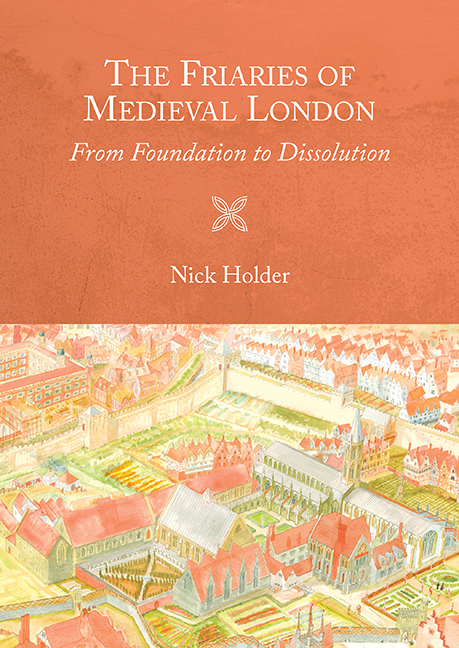Book contents
- Frontmatter
- Contents
- List of Illustrations and Tables
- Contributors
- Acknowledgements
- Abbreviations
- Introduction
- Part I The Nine London Friaries
- Part II The London Friars and their Friaries
- 10 Churches
- 11 Precincts and the Use of Space
- 12 Architecture and Architectural Fragments of the London Friaries
- 13 Floor Tiles and Building Materials from the London Friaries
- 14 Water Supply
- 15 Economy
- 16 Spiritual Life and Education in the London Friaries
- 17 Burial and Commemoration in the London Friaries
- 18 London Friars and Londoners
- 19 Dissolution
- Conclusions
- Timeline
- Bibliography
- Index
- Miscellaneous Endmatter
17 - Burial and Commemoration in the London Friaries
from Part II - The London Friars and their Friaries
Published online by Cambridge University Press: 16 May 2018
- Frontmatter
- Contents
- List of Illustrations and Tables
- Contributors
- Acknowledgements
- Abbreviations
- Introduction
- Part I The Nine London Friaries
- Part II The London Friars and their Friaries
- 10 Churches
- 11 Precincts and the Use of Space
- 12 Architecture and Architectural Fragments of the London Friaries
- 13 Floor Tiles and Building Materials from the London Friaries
- 14 Water Supply
- 15 Economy
- 16 Spiritual Life and Education in the London Friaries
- 17 Burial and Commemoration in the London Friaries
- 18 London Friars and Londoners
- 19 Dissolution
- Conclusions
- Timeline
- Bibliography
- Index
- Miscellaneous Endmatter
Summary
ON 24 October 1500 John Smith, gentleman of Coventry, made his will in which he asked to be buried in the Coventry Grey Friars:
I will that a lyke tombe of marbull be made and sett in the Wall there as my wif lyeth, lyke to a tombe in the Greyfreres of London made and sett there for William Maryner and his wiff wt lyke scripture and ymages as there is in every thing and according to suche covenants as [has] been specified in a peyre of Indentures not yet sealed whereof the oon parte of them is in my stody at London and the other parte remayneth wt the marbeler in Poules churche yerde and with more here lyeth John Smyth of Coventre gentleman and Johanne and Isabell his wiffes and so forth as is conteyned in the seid endenture.
Smith specified a monument ‘lyke to a tombe’ he had already seen during an earlier visit to the Franciscan convent in London. The Maryner tomb was, we know, a tumba elevata, that is a raised tomb. This probably consisted of a canopied tomb chest which contained a brass effigy of Maryner and his two wives, Agnes and Juliana, accompanied by an inscription. Smith had seen this, liked it and commissioned a London marbler to make one just like it to go over his own grave in Coventry. Within forty years almost all of the tombs from London's mendicant houses were destroyed but it is still possible to gain some impression of the lost landscape of these houses and to learn who chose to be buried in the five friaries of the city.
There are a number of written accounts which record London's lost tombs. The earliest manuscript was written c. 1500 and is now College of Arms MS CGY 647.3 The Tudor herald Sir Thomas Wriothesley, Garter King of Arms, later came to illustrate some of the tombs from London's mendicant houses and his account survives in British Library Add. MS 45131. This is known as the ‘Book of Funerals’ and was made during the 1520s.
- Type
- Chapter
- Information
- The Friaries of Medieval LondonFrom Foundation to Dissolution, pp. 272 - 292Publisher: Boydell & BrewerPrint publication year: 2017



